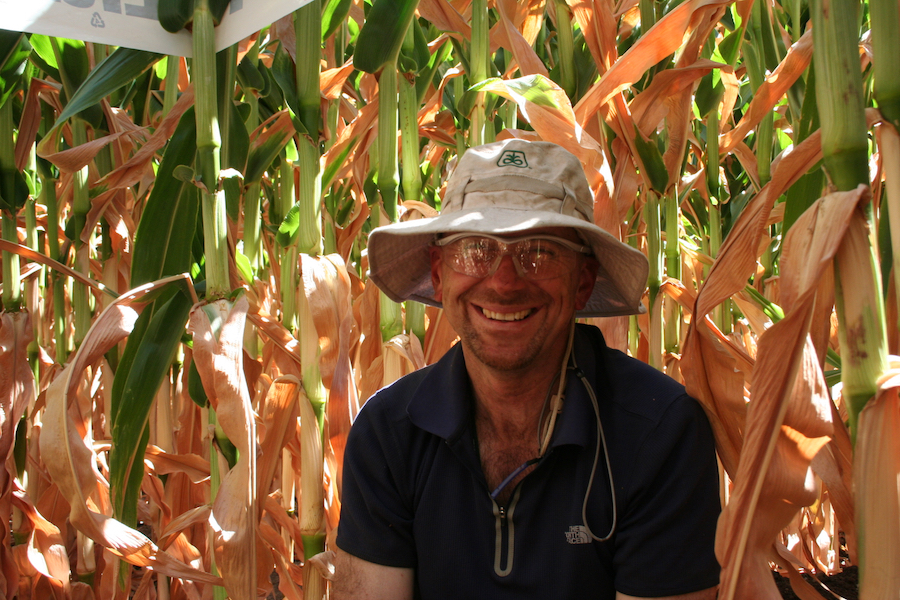The cutting-edge technology that produced America’s high-yielding, drought-tolerant AQUAmax maize hybrids is being adapted for use in Australian grain breeding programs.
The technology is a data and computationally rich method that simulates crop performance under different environmental conditions and management practices in such a way that it can identify the optimal genetics needed to close yield gaps within Australia’s highly variable environments.
The method works where other breeding technologies struggle because it can better account for the complex interactions that occur between genes (G), the environment (E) and crop management (M) – the so-called GxExM effect.
The new framework is called prediction-based crop breeding and its development owes a great deal to a collaboration between the University of Queensland and DuPont Pioneer that began in the 1990s.

The university’s Professor Mark Cooper played a central role when he transferred to DuPont Pioneer to push the technology’s development and its application to maize breeding. That effort culminated in the release of the popular AQUAmax hybrids.
In 2018, Professor Cooper returned to the university to test whether prediction-based breeding can close yield gaps for grains grown in Australia. The initiative has important implications since Australia is subject to some of the world’s most extreme environmental variability and, therefore, some of the most intense GxExM interactions.
This work is now underway through strategic investments by the Queensland Alliance for Agriculture and Food Innovation (QAAFI) at the University of Queensland and GRDC. The work will be developed further as part of the new Australian Research Council Centre of Excellence for Plant Success in Nature and Agriculture, where Professor Mark Cooper serves as deputy director.
“Accounting for GxExM interactions is central to our goal of helping to close gaps between realised and potential yield,” Dr Cooper says. “So, a key interest at the Centre of Excellence is developing predictive methodologies that can deal with genes operating in networks and interacting across different developmental processes and environments.”
As part of this initiative, a new project got underway in 2020 to use sorghum as a proof-of-concept crop that will lead the way applying the technology to Australian crops by exploiting advances made by the Centre of Excellence.
The sorghum project was made possible through GRDC investment and is run by Dr Owen Powell, who transferred to the University of Queensland from the Roslin Institute in Scotland.
“The exciting part is that any advance will drive additional capability for other crops,” Professor Cooper says. “So, sorghum is the first iteration. Like many new technologies, our intent is to refine and improve on the first generation.”

Sorghum leads the way
Dr Powell’s background is well-suited when it comes to applications of novel predictive methods.
At the Roslin Institute, located at the University of Edinburgh, he created computer simulations to test the effectiveness of different methods in use at the institute to improve yields in both livestock and hybrid crops.
This included genomic selection, a method based on whole-genome analysis using thousands of DNA markers. These markers are used to type genetic differences within breeding populations (a process called genotyping). By crunching huge amounts of genomic data against performance data from field trials, associations are made that reveal the best bits of DNA to bring together to improve on past varieties.
With the availability of genotyping data of sorghum lines from the work of the University of Queensland’s Dr Emma Mace and trait phenotyping from field experiments, genomic selection technology has already been applied to sorghum at the university. This took place within the pre-breeding program headed by Professor David Jordan.
The new project, however, will push past that existing capability: “What’s interesting about the new sorghum project is that genomic selection forms just one of two components used to make the predictions about the best arrangement of genes needed to improve crop performance,” Dr Powell says.
“The second component is the APSIM (Agricultural Production Systems sIMulator) crop growth models developed at University of Queensland by Professor Graeme Hammer and his team that simulate impacts on crops from environmental causes.”
The inclusion of crop growth modelling, however, meant that the algorithms needed to be adapted for different crop types, since differences in biology between crops matter with prediction-based breeding.
For example, Dr Powell has started working on tillering in sorghum, which was not an element of the maize crop models but is a key piece of biology in sorghum. “That has a significant impact in GxExM interactions,” Dr Powell says. “So, we’re trying to understand how strong an influence tillering, in combination with other traits, will have on predicting crop performance and yield.”
“However, once the two modelling frameworks – genomic and crop growth – are integrated and adapted to specific crops, the result is a game-changing gain in unique insights about genotype fitness against real-life conditions in the paddock”.
Importantly, this approach is much faster than traditional breeding and it also results in a blueprint that outlines how to bring together optimal gene combinations. As such, the technology stands to accelerate the breeding process.
That is the capability that the Centre of Excellence for Plant Success is attempting to engineer for Australian grains and that Dr Powell will roll out – first cab off the rank – in sorghum.
“It’s ultimately about getting the right variety into the right paddock for the right market,” Professor Cooper says.
That objective makes GRDC’s investment in Dr Powell and the sorghum project one that is foundational to making an important step change in breeding capability. Following the lifting of COVID-19-related travel restrictions, Dr Powell is also looking forward to visiting growers around Australia to discuss these opportunities.

Improvement is possible
“No one at the university yet knows how much extra yield or yield resilience is possible using prediction-based crop breeding. What the researchers do know is that the method being applied has a track record of successfully accounting for GxExM interactions”.
That conclusion is supported by studies published by Professor Cooper. In one such work, he and his US team examined impacts from droughts that the US maize industry considered impossible to anticipate.
When the analysis was made using Professor Cooper’s maize-adapted algorithms, the modelling accurately predicted the impacts of standout drought events and did so despite these events being excluded from the software’s training dataset.
“We’ve tested this approach with some of the industry’s more difficult problems in the US,” Professor Cooper says. “Given the larger GxExM influence in Australia, it’s possible we may see even more upward potential from applying these predictive frameworks here in Australia.”
Contacts: Professor Mark Cooper, Chair Crop Improvement, Centre for Crop Science, QAAFI, The University of Queensland, T. +61 7 33462778
E. mark.cooper@uq.edu.au and Dr Owen Powell, Centre for Crop Science, QAAFI, The University of Queensland, E. o.powell2@uq.edu.au.
Source: Breeding with an eye on genes for paddocks first published in GRDC Groundcover.
The Queensland Alliance for Agriculture and Food Innovation is a research institute at The University of Queensland, established with and supported by the Queensland Department of Primary Industries.

